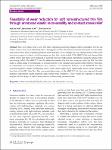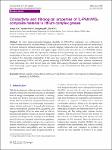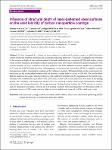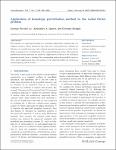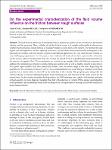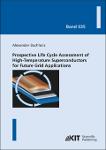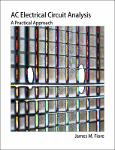Search
Author
- Amir, Ebrahimi (2)
- Aydin, Azizi (2)
- George, Haller (2)
- James, M. Fiore (2)
- next >
Subject
- Engineering (4)
- công nghệ (3)
- kỹ thuật (3)
- Robotics (3)
- next >
Date issued
Has File(s)
- true (215)
Search Results
This work shows that a soft, thin film comprising randomly aligned carbon nanotubes (CNTs) can reduce surface wear more effectively than a homogeneous thin film because of enhanced elastic recoverability and contact stress relief originating from its mesh structure. To investigate the wear characteristics of the mesh structure compared to those of the homogeneous thin film, multi-walled CNTs (MWCNTs) and diamond-like carbon (DLC) thin films were prepared to conduct nanoscale tribological experiments using the atomic force microscopy (AFM). The MWCNT thin film showed unmeasurably low wear compared with the DLC thin film under a certain range of normal load. To demonstrate the wear reduction mechanism of the MWCNT thin film, its indentation and frictional behaviors were assessed. |
Conductivity and tribological properties of IL-PANI/WS2 composite material in lithium complex grease An ionic liquid-polyaniline/tungsten disulfide (IL-PANI/WS2) composite was synthesized in 1-butyl-3-methylimidazole tetrafluoroborate (LB104) aqueous solution by in-situ polymerization and characterized by Fourier transform infrared spectroscopy. A current-carrying friction and wear tester was used to study the tribological properties of steel—steel and copper—copper friction pairs lubricated by an IL-PANI/WS2 lithium complex grease (LCG). After the experiment, scanning electron microscope was used to observe the surface morphology of the wear scar on the steel and copper plates, and X-ray photoelectron spectrometer was used to analyze the elemental composition of the wear scar surface. The results show that compared with greases containing IL-PANI and WS2, greases containing IL-PAN... |
Carbon nanoparticle coatings on laser-patterned stainless-steel surfaces present a solid lubrication system where the pattern’s recessions act as lubricant-retaining reservoirs. This study investigates the influence of the structural depth of line patterns coated with multi-walled carbon nanotubes (CNTs) and carbon onions (COs) on their respective potential to reduce friction and wear. Direct laser interference patterning (DLIP) with a pulse duration of 12 ps is used to create line patterns with three different structural depths at a periodicity of 3.5 µm on AISI 304 steel platelets. |
The dynamics of a spacecraft propelled by a continuous radial thrust resembles that of a nonlinear oscillator. This is analyzed in this work with a novel method that combines the definition of a suitable homotopy with a classical perturbation approach, in which the low thrust is assumed to be a perturbation of the nominal Keplerian motion. The homotopy perturbation method provides the analytical (approximate) solution of the dynamical equations in polar form to estimate the corresponding spacecraft propelled trajectory with a short computational time. The accuracy of the analytical results was tested in an orbital-targeting mission scenario. |
This book aims to narrate fundamental concepts of structural design to architecture students such that they have minimum involvement with math problem-solving. Within this book, students learn about different types of loads, forces and vector addition, the concept of equilibrium, internal forces, geometrical and material properties of structural elements, and rules of thumb for estimating the proportion of some structural systems such as catenary cables and arches, trusses, and frame structures. |
The load-bearing behaviour of lubricated contacts depends primarily on the normal force, the relative velocity, and the geometry. Thus, with the aid of the Stribeck curve, it is usually well possible to characterize whether hydrodynamics, mixed friction, or boundary friction is more likely to be present. The fact that the load regime can also depend on the fluid quantity is obvious, but has hardly been systematically investigated so far. Especially for contacts with microscopic roughness, the defined application of a very small amount of fluid is a very challenging requirement. In this paper, a very fundamental study shows how a pin-on-disc tribometer can be used to achieve the transition from dry friction via mixed friction to predominant hydrodynamics by the amount of supplied flu... |
A new type of lubricating material (BTA-P4444-Lig) was synthesized by combining lignin with tetrabutylphosphorus and benzotriazole. The tribological properties, corrosion resistance, and anti-oxidation properties of BTA-P4444-Lig as a lubricant were investigated. The lubricating material exhibits excellent friction reduction and wear resistance, as well as good thermal stability and excellent oxidation resistance. Mechanistic analysis reveals that the active elements N and P in the lubricating material react with the metal substrate, and the reaction film effectively blocks direct contact between the friction pairs, affording excellent friction reduction and wear resistance. At the same time, the phenolic hydroxyl group in lignin reacts with oxygen free radicals to form a resonance-... |
High-temperature superconductors have distinct advantages compared to conventional conductors. Below their critical temperature, superconductors have immeasurably low ohmic losses. To maintain the superconducting state, superconductors require constant cooling. This study aims at identifying the environmental impacts of the application of superconductors in future grid technologies such as superconducting power cables. |
The last decade has witnessed a surge of interest in artificial neural network in many different areas of scientific research. Despite the rapid expansion in the application of neural networks, few efforts have been carried out to introduce such a powerful tool into lubrication studies. Thus, this work aims to apply the physics-informed neural network (PINN) to the hydrodynamic lubrication analysis. The 2D Reynolds equation is solved. The PINN is a meshless method and does not require big data for network training compared with classical methods. Our results are consistent with those obtained by experiments and the finite element method. Hence, we envision that the PINN method will have great application potential in lubrication and bearing research. |
This text is based on the earlier Workbook for AC Electrical Circuits, which it replaces. The original expository text has been greatly expanded and includes many examples along with computer simulations. For the convenience of those who used the Workbook, many of the problem sets are the same, with some re-ordering depending on the chapter. |

